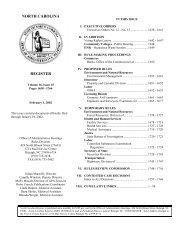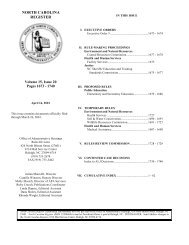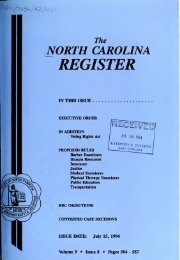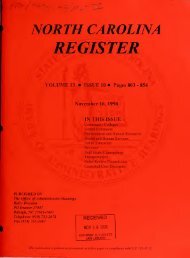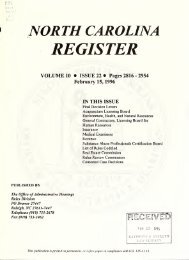NC Register Volume 21 Issue 09 - Office of Administrative Hearings
NC Register Volume 21 Issue 09 - Office of Administrative Hearings
NC Register Volume 21 Issue 09 - Office of Administrative Hearings
You also want an ePaper? Increase the reach of your titles
YUMPU automatically turns print PDFs into web optimized ePapers that Google loves.
CONTESTED CASE DECISIONS<br />
these characteristics is altered by non-natural activities. For example, a stream may no longer be able to support the natural biological<br />
diversity in the stream.<br />
12. Land development is one type <strong>of</strong> non-natural activity that causes water quality degradation. In particular, increased<br />
stormwater run<strong>of</strong>f arising from construction and post-construction land development activities causes significant water quality<br />
degradation and aquatic habitat loss, resulting in lowered biological integrity for aquatic systems.<br />
13. Stormwater run<strong>of</strong>f occurs when impervious surfaces increase within a watershed and rainfall can no longer infiltrate<br />
into soils. Surfaces that water cannot effectively pass through, such as asphalt, concrete, ro<strong>of</strong> shingles, metal, gravel, and compacted<br />
soils.<br />
14. Impervious surfaces collect pollutants, such as nutrients, sediment, petroleum products, and fecal coliform,<br />
deposited from other sources. During storm events, these collected pollutants are washed into aquatic systems as stormwater run<strong>of</strong>f.<br />
15. Numerous scientific studies have shown that increased impervious surface in a watershed is correlated with water<br />
quality degradation. These studies have documented significant water quality degradation in streams draining watersheds with<br />
impervious surface area from zero to thirteen percent. One such study found that there is no safe threshold for impervious surface area<br />
because any increase in impervious surface results in detrimental impacts to sensitive aquatic species.<br />
16. Increased stormwater run<strong>of</strong>f from impervious surfaces also causes increased run<strong>of</strong>f volume which detrimentally<br />
affects channel stability in aquatic systems. Stream channels will either widen their stream banks, down cut the stream bed, or do both<br />
to accommodate larger and more severe run<strong>of</strong>f events. The sediment from the eroded stream banks and bed will increase sediment<br />
loading in the stream.<br />
17. Because increased impervious surfaces reduce the amount <strong>of</strong> natural infiltration in a watershed, groundwater<br />
recharge is also reduced. Groundwater contributes to a stream’s base flow, which is the portion <strong>of</strong> water that comes from sources other<br />
than surface run<strong>of</strong>f. Thus, when groundwater recharge is reduced, base flow in streams is also reduced.<br />
18. The NPDES Phase II stormwater permits at issue in these proceedings are intended to regulate new discharges <strong>of</strong><br />
stormwater pollution from urban land development and to ameliorate the effects <strong>of</strong> stormwater pollution. Each permit contains six<br />
minimum measures consisting <strong>of</strong>: (1) public education; (2) public involvement in designing program; (3) illicit discharge detection<br />
and elimination; (4) construction site stormwater pollution control; (5) post-construction stormwater management; and (6) pollution<br />
prevention.<br />
19. The NPDES Phase II stormwater permits at issue in these proceedings establish model practices for postconstruction<br />
stormwater controls that constitute the minimum measures that must be implemented under the NPDES Phase II<br />
program. These model practices include a low-density option and a high-density option for stormwater controls in new development.<br />
20. The low-density option applies to any new development that involves up to, but no more than, twenty-four percent<br />
impervious surface area or “built-upon area.” Under this option, the only post-construction stormwater management measures are<br />
vegetated conveyances for transporting stormwater to the nearest stream and a thirty-foot setback from the stream for all impervious<br />
surfaces.<br />
<strong>21</strong>. The high-density option applies to any new development that involves more than twenty-four percent impervious<br />
surface area. Under this option, the stormwater measures require a thirty-foot setback from the stream for all impervious surfaces and<br />
require the installation <strong>of</strong> engineered structural controls. The structural controls must treat the difference between the pre- and postdevelopment<br />
run<strong>of</strong>f for a certain design storm and remove eighty-five percent <strong>of</strong> all total suspended solids (“TSS”). The design storm<br />
included in the model practices is the one year, twenty-four hour storm.<br />
22. All three <strong>of</strong> the challenged NPDES Phase II stormwater permits incorporate these model practices as the postconstruction<br />
measures included in the permits themselves. These three NPDES Phase II stormwater permits authorize discharges <strong>of</strong><br />
stormwater pollution into the Goose Creek watershed from the following sources: (1) Mecklenburg County, specifically as it includes<br />
discharges from the Town <strong>of</strong> Mint Hill; (2) the Town <strong>of</strong> Indian Trail; and (3) the Town <strong>of</strong> Stallings.<br />
23. Goose Creek is a perennial stream with its watershed located in southeastern Mecklenburg County and northwestern<br />
Union County, North Carolina. Goose Creek has its headwaters in southeastern Mecklenburg County within the jurisdiction <strong>of</strong> the<br />
Town <strong>of</strong> Mint Hill. Stormwater run<strong>of</strong>f from portions <strong>of</strong> the Towns <strong>of</strong> Indian Trail, Stallings, and Mint Hill drains into Goose Creek.<br />
Duck Creek is the other main tributary in the Goose Creek watershed and is a perennial stream.<br />
<strong>21</strong>:<strong>09</strong> NORTH CAROLINA REGISTER NOVEMBER 1, 2006<br />
869




